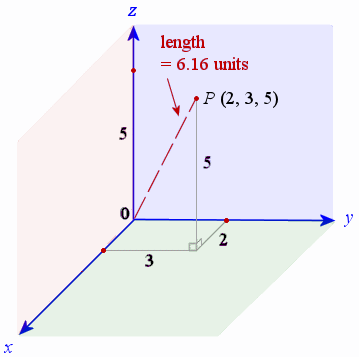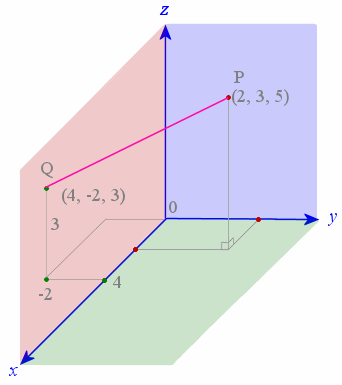6. The 3-dimensional Co-ordinate System
We can expand our 2-dimensional (x-y) coordinate system into a 3-dimensional coordinate system, using x-, y-, and z-axes.
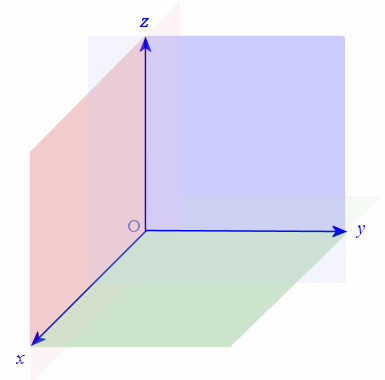
The x-y plane is horizontal in our diagram above and shaded green. It can also be described using the equation z = 0, since all points on that plane will have 0 for their z-value.
The x-z plane is vertical and shaded pink above. This plane can be described using the equation `y = 0`.
The y-z plane is also vertical and shaded blue. The y-z plane can be described using the equation `x = 0`.
We normally use the 'right-hand orientation' for the 3 axes, with the positive x-axis pointing in the direction of the first finger of our right hand, the positive y-axis pointing in the direction of our second finger and the positive z-axis pointing up in the direction of our thumb.
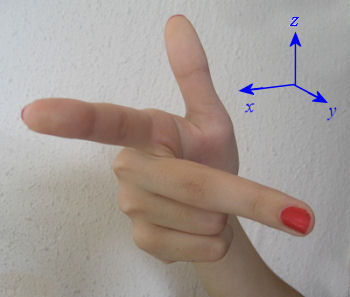
Example - Points in 3-D Space
In 3-dimensional space, the point `(2, 3, 5)` is graphed as follows:
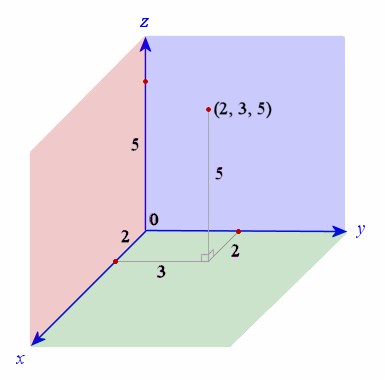
To reach the point `(2, 3, 5)`, we move `2` units along the x-axis, then `3` units in the y-direction, and then up `5` units in the z-direction.
You can explore this example in 3D space using this applet:
Distance in 3-dimensional Space
To find the distance from one point to another in 3-dimensional space, we just extend Pythagoras' Theorem.
Distance from the Origin
The general point P (a, b, c) is shown on the 3D graph below. The point N is directly below P on the x-y plane.
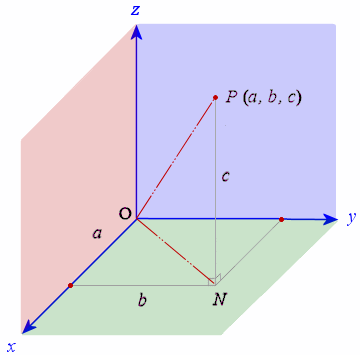
The distance from `(0, 0, 0)` to the point P (a, b, c) is given by:
`"distance"\ OP = sqrt (a^2+ b^2+ c^2)`
Why?
The point N `(a, b, 0)` is shown on the graph. From Pythagoras' Theorem,
`"distance"\ ON = sqrt (a^2+ b^2)`
and squaring both sides gives:
`(ON)^2=a^2+b^2`
Distance NP is simply c (this is the distance up the z-axis for the point P).
Applying Pythagoras' Theorem for the triangle ONP, we have:
`"distance"\ OP = sqrt ((ON)^2+ c^2)`
`= sqrt (a^2+ b^2+ c^2)`
Example 1 - Distance from the Origin to a Point
Find the distance from the origin O to the point B `(2, 3, 5)`. This is the example from above.
Answer
`"distance"\ OB= sqrt (2^2+ 3^2+5^2)= sqrt (38)=6.16\ "units"`
This is how it looks on the 3-D graph:
Distance Between 2 Points in 3 Dimensions
If we have point A (x1, y1, z1) and another point B (x2, y2, z2) then the distance AB between them is given by the formula:
`"distance"\ AB = ` `sqrt ((x_2-x_1)^2+ (y_2-y_1)^2+ (z_2-z_1)^2)`
This is just an extension of the distance formula (from the origin to a point) that we met above.
Example 2 - Distance between 2 points
Find the distance between the points P (2, 3, 5) and Q (4, -2, 3).
Answer
The point Q `(4, -2, 3)` is shown on the graph and the distance PQ required is indicated in pink:
Using the formula, we have:
`"distance"\ PQ = sqrt ((x_2-x_1)^2+ (y_2-y_1)^2+ (z_2-z_1)^2)`
`= sqrt ((2-4)^2+(3-(-2))^2+(5-3)^2)`
`=5.74\ "units"`
